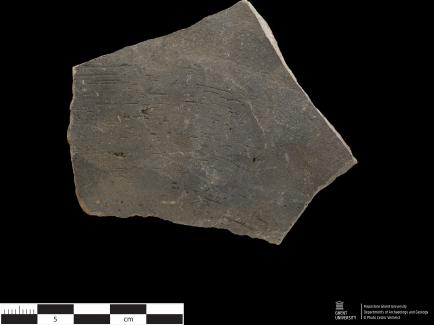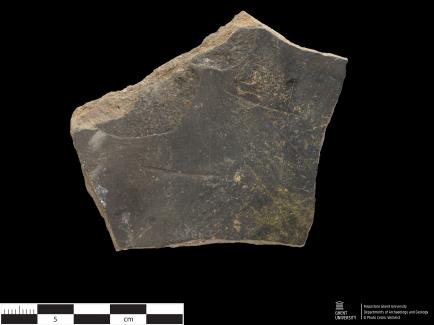Medieval - Grey reduced ware (6.GR.BE.0025)
Hand specimen pictures (macro & binocular)
Thin section pictures
Find location
- Category
- Grey reduced ware (Medieval)
- Fabric name
- Chronology
- Medieval > Late Medieval > 1300-1350
- Dating method(-s)
- typology
- Potters' mark
- No
- Additional information
Find location
- Site type
- Pottery production
- Location
- Belgium; Antwerpen; Mechelen
- Site name
- Mechelen, Jodenstraat
- Excavation or Survey Team
- W. De Jonge, D. De Preter (v.z.w. Archeologisch Erfgoed Mechelen)
- Additional contextual information
- feature 4; categorized as loose finds; potters waste assemblage found during construction works in the Jodenstraat (1991-1997); ground plans and other scientific documentation are lacking; the ceramic assemblage has been studied in the framework of the doctoral research of A. De Poorter (De Poorter 2005)
- Surface color
- dark grey
- Surface texture
- Rough
- Fracture color
- light brown-light grey
- Inclusions (non-plastics/tempering)
- quartz (some rare large grains, 1 mm); oval brown inclusions (ranging between <1 up to 4 mm), rare black inclusions (vegetal ?)
- Matrix and voids
- small vesicles, large vughs
- Diagnostic features
- Additional information
- sample MECH_JS_ST5
- Flepostore inventory nr.
- ARCH1.L1.B13a
- Original inventory nr.
- A0029
- Collection
- Archaeological Department, Ghent University
- Type
- Covered thin section
- Comparable thin section(s)
- Matrix
-
Reduced layered fabric with grey core, brown outer layers and dark brown edge (surface); core to edge: black - brown - black (PPL), black - dark brown - black (XP).
Semi-homogenous matrix, non-calcareous with no to low optical activity.
- ca. 55-65% - Inclusions
-
Quartz (++; mono+, poly-, cf: r-sr, medium to coarse sand, ff: sr-sa, very fine to fine sand, bimodal from sand temper), sedimentary rock detritus (+-; quartz arenite), chert/flint (+-), low grade metamorphic rock detritus (+-), feldspars (+-; plagioclase, microcline, orthoclase), muscovite mica (+; eq & el, ff), glauconite (+-; r, greenbrown to brown body color), O/Fe (+), clay pellets (+-; iron-rich) and semi-plastics (-).
The coarse fraction consists of medium to coarse sand, the fine fraction consists of fine to very fine sand. Grains are generally rounded to subangular. Overall the fabric is very pooly to poorly sorted and poorly orientated, single to double spaced.
- ca. 25-30% - Voids
-
Many small planar voids and few larger vughs, well aligned, some infill.
- ca. 10-15% - Diagnostic features
- The fabric is characterized by a semi-homogeneous reduced layered matrix with no to low optical activity and moderate porosity. Dominant quartz inclusions with frequent muscovite mica and opaques/iron oxides, common sedimentary rock detritus, chert/flint, low grade metamorphic rock detritus, feldspars, glauconite and clay pellets, and few semi-plastics. Overall (very) poorly sorted fabric. Clear bimodal distribution, possibly added sand temper.
- Additional information
- Possible addition of glauconitic sand, similar to A0028.3 (different firing).
- Sample type
- Pottery
- Inventory number
- 6.GR.BE.0025
- Collection
- Archaeological Department, Ghent University
- Donating institute/person
- Museum Kunst & Geschiedenis (Jubelparkmuseum/Le Musée du Cinquantenaire)
- Host collection
- Museum Kunst & Geschiedenis (Jubelparkmuseum/Le Musée du Cinquantenaire)
- Other samples available
- No
- Sample collection method
- Loose Find
De Poorter 2001
- Full reference
-
De Poorter A. 2001. Pottenbakkersafval van laatmiddeleeuws hoogversierd aardewerk uit Mechelen. Vormen uit het vuur. Mededelingsblad Nederlandse vereniging van vrienden van ceramiek
en glas 174: 8-25.
De Poorter 2005
- Full reference
-
De Poorter A. 2005. Gebruiksaardewerk in het zuidelijk gedeelte van het voormalig Hertogdom Brabant (1200-1800). Doctoraal proefschrift ingediend tot het bekomen van de graad van doctor in de Kunstwetesnchappen en Archeologie, Vrije Universiteit Brussel. Brussel.
Cite this page as: Flepostore - https://flepostore.ugent.be/ceramics/6-gr-be-0025
Last modified: 2024-04-24.





